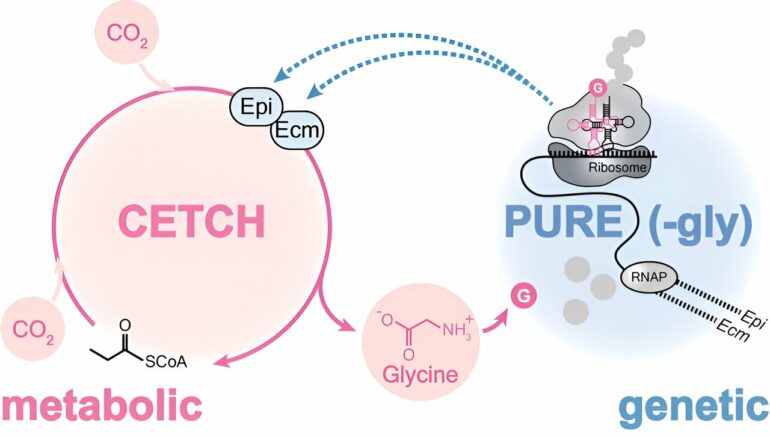The capacity of all living systems to develop, organize and sustain themselves is based upon a cyclical process in which genes and metabolism interact in parallel. While genes encode the components of metabolism, metabolism provides the energy and building blocks to maintain and process genetic information.
In synthetic biology, researchers explore the principles of life by reconstructing its systems from the bottom-up, starting with the minimum number of parts required. In recent years, this approach has made it possible to develop complex metabolic networks and cell-free genetic systems outside the cell environment—in vitro—for example, in microfluidic chambers.
What these approaches have in common is that all the biocatalysts that function in these systems are added from the outside, and the whole process only continues as long as it is supplied with a continuous stream of new building blocks, information and energy.
By interlinking the metabolic and genetic levels, researchers want to create self-sustaining synthetic biological systems that can generate their own building blocks and drive processes in a reciprocal manner—just like in living cells. A team led by Tobias Erb from the Max Planck Institute for Terrestrial Microbiology in Marburg, Germany, has now made a significant step towards this goal.
The team has developed the first cell-free system in which a genetic and a metabolic network keep each other running. The system produces metabolic enzymes itself and works both in the test tube and in artificial cell-mimics. It is based on the synthetic Cetch cycle, a metabolic network that uses CO2 as a raw material to produce organic molecules.
The work is published in the journal Science.
The trick: Interdependence
“We coupled the Cetch cycle with an existing genetic system called Pure, a synthetic transcription and translation machine that works with a mixture of ribosomes, DNA, RNAs, and proteins, outside living cells. We engineered the two levels to work together like an engine. Once started, it keeps going because the two networks feed on each other,” explains Simone Giaveri, EMBO fellow and first author of the paper.
To make this work, the researchers made the components dependent on each other. They programmed Pure to produce two of the Cetch enzymes. However, this Pure variant lacks the essential amino acid glycine, which is needed to build proteins. Cetch was modified to produce glycine directly from CO2. As Pure obtains the glycine from Cetch, the cycle is closed.
To prove that their approach worked, the researchers first added glycine to Pure, which contained the information for the production of a fluorescent protein. Its glow indicated the sought-after activity of the genetic network. The next step was to introduce the synthetic Cetch cycle. Once the synthetic pathway was introduced, the coupled system became capable of producing the glycine itself—and in turn two proteins of the Cetch, as well as the fluorescent protein.
Of the more than 50 proteins in the system, the system produces only two by itself. Yet that is all that is needed to drive the synthetic cycle.
“Without the genetic component and the mutual feedback, the cycle would only run for less than one hour. The fact that there is self-regeneration means that it will last at least twelve hours before the system stops for various reasons, for example, because components fail, or byproducts accumulate too much,” explains Giaveri. “You have to start it with a minimal amount of glycine and it will keep going.”
Most of the elements of the synthetic metabolism are still provided from outside.
“We’re still a long way from a system that can regenerate all its own components,” says Erb. This would involve encoding complete metabolic networks, coding self-repair programs to extend the lifespan of in vitro systems, as well as integrating biochemical recycling cycles.
“So far, we have only managed to produce one building block, and we are still a long way from being able to produce all the building blocks from CO2. However, we have developed a basic operating system that will benefit from future developments in this fast-moving field of research. Looking even further into the future, you can imagine that in the future we will be able to run such a system on light or even sustainable electricity.”
A basic operating system for future sustainable systems
The orchestration of more than 50 proteins, energy sources, genetic information and building blocks is the result of an enormous number of experiments in which Giaveri tested and optimized combinations in parallel. Each element in Giaveri’s highly complex system is precisely designed for its purpose.
“You can use our system as an operating unit, as a basic engine for in vitro systems,” says Erb. “And because it is based on CO2, this would become possible in a fully sustainable way, because this raw material is available in practically unlimited quantities.”
More information:
Simone Giaveri et al, Integrated translation and metabolism in a partially self-synthesizing biochemical network, Science (2024). DOI: 10.1126/science.adn3856
Provided by
Max Planck Society
Citation:
Team develops the first cell-free system in which genetic information and metabolism work together (2024, July 11)



